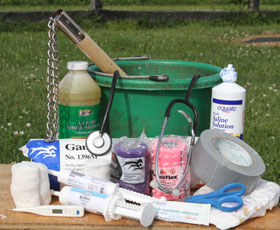
Disaster Planning for Horse Owners
Part 1: Identification & Vaccinations
Hurricane season is upon us as well as tornadoes and flooding and drought. Summer is fraught with potential disasters that may affect your farm and horses. No one wants to think of disaster planning when you have stalls to pick, water buckets to clean and feed to prep. But how would you protect your prized equines without one?
It might be beneficial to meet with your neighbors and devise a game plan together. In this way, equipment, concrete floored barns and high pastures could be shared among those in need.
IDENTIFICATION
What if your horses escaped through a broken fence during a storm? Is he micro chipped? Is your phone number written with indelible ink on the halter? Here are some recommendations from horse owners after hurricane Andrew left 80% of found horses without identification.
 If you have a smart phone, take pictures of all your horses and their records. If you don’t have a cell phone like this, take a digital picture of the horse with a family member and pictures of all records. If you can’t take any pictures, staple a copy of your horse’s Coggins to a picture of him, along with pertinent physical information such as scars and tattoos. Keep all this in a zip-lock bag where you can easily find it.
If you have a smart phone, take pictures of all your horses and their records. If you don’t have a cell phone like this, take a digital picture of the horse with a family member and pictures of all records. If you can’t take any pictures, staple a copy of your horse’s Coggins to a picture of him, along with pertinent physical information such as scars and tattoos. Keep all this in a zip-lock bag where you can easily find it.
- Attach a leather luggage tag on a tear-away halter to include the horse’s name, address, phone number and owner’s name. If your horse has special medical needs, note this on an index card, place it in a small zip-lock and wrap it with tape around the halter.
- In case the halter comes off during the storm, braid a second luggage tag containing the same information into the horse’s tail or mane. Do not tie the tag as this would cause harm to the horse.

- You may want to purchase fetlock ID bands to place on both front feet making sure to leave them loose enough but not too loose that they would fall off.
- Last but not least, you could clip your phone number on the horse. It won’t look pretty, but at least people would know how to reach you.
VACCINATIONS & EMERGENCY KITS
Speak with your vet and keep all vaccinations up-to-date – especially the tetanus and encephalitis. Make sure you have multiple ways to contact your vet in case power is out and you need to reach him.
Have an Emergency Barn Kit and an Equine First Aid Kit stashed in a secure location.
- Emergency Barn Kit should include (but not be limited to)

- Doctor, police and fire department contact information,
- Human emergency kit,
- chain saw & fuel,
- hammers,
- saw,
- nails,
- screws,
- fencing materials,
- duct tape,
- flashlights and batteries.
- Equine First Aid Kit should include (but not be limited to)

- Veterinarian phone number (In the event of an injury, call vet firstand follow instructions)
- Extra halters and lead ropes,
- medications,
- salve & ointments,
- thermometer,
- latex gloves,
- antiseptic scrub solution like betadine,
- scissors,
- wraps,
- bandages,
- tape, and whatever else you might need.
The University of Minnesota fact sheet “Equine first aid: what to have and how to use it” is a great article on what to have in the kit and how to use it. I highly recommend you thoroughly read this.
* The information provided here is intended to be a brief summary. Please contact Star H Equine Insurance and/or review your policy for more detailed information.
Copyright © 2015 -
Star H Equine Insurance. All rights reserved
- Web/Graphic Design & Site Maintenance Karin Hinzmann



 We are licensed in all states but Alaska!
We are licensed in all states but Alaska!